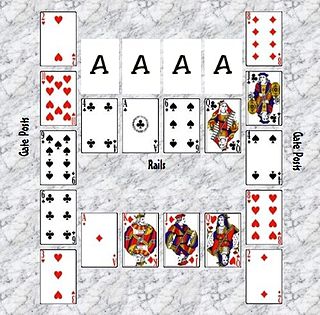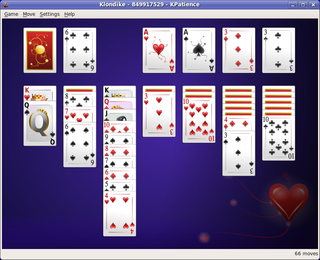
Quadrille, also called Captive Queens, La Française or Partner is a card game of the Patience or Solitaire type using a pack of 52 playing cards. The name Quadrille is derived from the layout of the four Queens around which the cards are built. The alternative name, Captive Queens, describes the way the Queens become "enclosed" as the foundations are built upon.
Congress is a patience or solitaire card game using two decks of 52 playing cards each. It is a simple but strategic game which requires skill and careful choosing for it to be completed successfully. It is closely related to Forty Thieves but with eight instead of ten columns. It is sometimes called President's Cabinet, and can typically be completed successfully less than once in 20 games.
Sir Tommy, also called Old Patience, is a patience or solitaire card game using a single pack of 52 playing cards. It is said to be the ancestor of all patiences, hence its alternative title. It is a half-open, planner type of patience game in the same family of card-building games as Calculation and Strategy. It is also known as Try Again and Numerica.

Crazy Quilt is a solitaire card game using two decks of 52 playing cards each. The game is so-called because the reserve resembles the weaves of a carpet or an arrangement of a quilt, with cards alternating vertical and horizontal rotations. The arrangement of the cards on the reserve is also the reason it is rarely seen on computer solitaire packages, most of which have their cards placed vertically.
St. Helena is a solitaire card game using two decks of playing cards mixed together. Despite its name, it has no connection to the island with the same name, nor should it be confused with a different solitaire game that has a similar name, i.e. the more well-known Napoleon at St. Helena, usually called Forty Thieves.
Eagle Wing is a Patience game which is played with a deck of 52 playing cards. The game takes its name from the tableau which depicts an eagle-like bird spreading its wings in flight. It is somewhat related to the Canfield variant Storehouse.

Diplomat is a patience or solitaire card game which is played using two decks of playing cards shuffled together. Its layout is similar to that of Beleaguered Castle, and the game-play is similar to Forty Thieves. It can be completed successfully more often than not.
Queen of Italy is a solitaire card game played with two decks of playing cards. It is a very strategic game that rewards careful planning, since the cards that potentially block the game are presented at the start, and with care it can be completed about half the number of attempts.
Duchess is a patience or solitaire card game which uses a deck of 52 playing cards. It has all four typical features of a traditional solitaire game: a tableau, a reserve, a stock and a waste pile, and is quite easy to win. It is closely related to Canfield.

Colorado is a solitaire card game which is played using two decks of playing cards. It is a game of card building which belongs to the same family as games like Sir Tommy, Strategy, and Calculation. It is considered an easy game with 80% odds of being completed successfully.
Puss in the Corner, also called Puss in Corner is a patience or solitaire card game that is played with a single pack of 52 playing cards. It is of the half-open, planner type and is a "thinly disguised variant of Sir Tommy," but with modifications and with the waste piles placed at the corners of the foundations, hence the name. It has the rare feature that the suits are built up in colour, not in suit.
Intrigue is a solitaire card game which is played using two decks of playing cards. It is similar to another solitaire game called Salic Law, but it also involves the queens and building in the foundations goes both ways.
Deuces is a solitaire card game which is played with two decks of playing cards. It is so called because each foundation starts with a "deuce", or two card. It also belongs to a family of card games which includes Busy Aces, which is derived from Forty Thieves.
Four Seasons is a solitaire card game which is played with a single deck of playing cards. It is also known as Corner Card and Vanishing Cross, due to the arrangement of the foundations and the tableau respectively. Another alternate name is Cross Currents.
Patriarchs is a solitaire card game which is played with two decks of playing cards. It is similar in reserve layout to Odd and Even but with different game play.
Contradance is a solitaire card game which is played with two decks of playing cards. It is probably so called because when the game is won, it shows the king and the queen of each suit about to do a dance, the cotillion being a country dance from the 18th century.
Frog is a patience or solitaire card game which is played with two decks of playing cards. It belongs to the same family of solitaire games as Strategy, Sir Tommy, Calculation, and Puss in the Corner. Game-play is like Sir Tommy, but with two decks, a fifth waste pile, and a Canfield-like reserve.
Zodiac is a solitaire card game which is played with two decks of playing cards shuffled together. An old game, it first appeared in Lady Adelaide Cadogan's book Illustrated Games of Patience. It is so-named probably because of its "globe"-shaped layout. It had many variations until its rules were standardized in 1914.

Gate is a solitaire card game played using a deck of 52 playing cards, and is a member of the Canfield family. It gets its name because the cards are laid out in such a way that they form a gate. Average players can expect to win 99% of their games.

Patience (Europe), card solitaire or just solitaire (US/Canada), is a genre of card games that can be played by a single player. Patience games can also be played in a head-to-head fashion with the winner selected by a scoring scheme.








